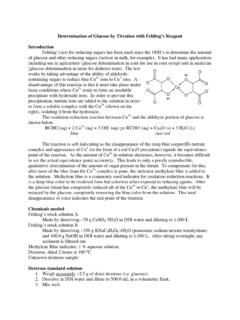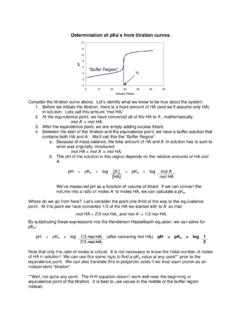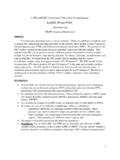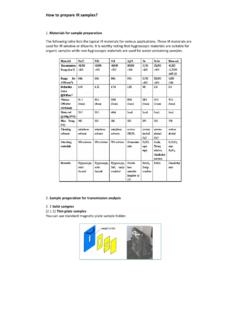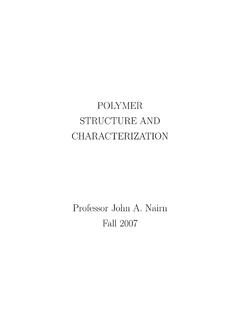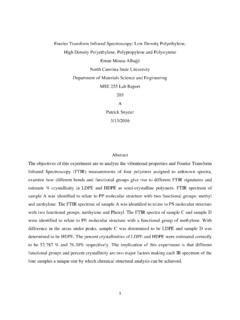Transcription of An Introduction to Instrumental Methods of Analysis
1 1An Introduction to Instrumental Methods of Analysis Instrumental Methods of chemical Analysis have become the principal means of obtaining information in diverse areas of science and technology. The speed, high sensitivity, low limits of detection, simultaneous detection capabilities, and automated operation of modern instruments, when compared to classical Methods of Analysis , have created this predominance. Professionals in all sciences base important decisions, solve problems, and advance their fields using Instrumental measurements. As a consequence, all scientists are obligated to have a fundamental understanding of instruments and their applications in order to confidently and accurately address their needs. A modern, well-educated scientist is one who is capable of solving problems with an analytical approach and who can apply modern instrumentation to With this knowledge, the scientist can develop analytical Methods to solve problems and obtain appropriately precise, accurate and valid information.
2 This text will present; 1) the fundamental principles of Instrumental measurements, 2) applications of these principles to specific types of chemical measurements (types of samples analyzed, figures of merit, strengths and limitations), 3) examples of modern instrumentation, and 4) the use of instruments to solve real analytical problems. The text does not include information on every possible analytical technique, but instead contains the information necessary to develop a solid, fundamental understanding for a student in an upper level undergraduate class in Instrumental Analysis . 1-1. Background Terminology: Before presenting the complete picture of a chemical Analysis , it is important to distinguish the difference between an analytical technique and an analytical An 2analytical technique is considered to be a fundamental scientific phenomenon that has been found to be useful to provide information about the composition of a substance.
3 Examples of analytical techniques include infrared spectrophotometry (IR) or inductively coupled plasma atomic emission spectrometry (ICP-AES). An analytical method involves the use of an analytical technique, operated within specific and appropriate measurement parameters, for solving a problem. The Analysis of styrene-acrylonitrile copolymers using infrared spectrophotometry and the determination of lead in drinking water using ICP-AES are both examples of analytical Methods . It is also important to differentiate the terms procedure and protocol. A procedure represents a set of written instructions for carrying out the steps of an analytical method. Organizations such as the American Society for Testing Materials (ASTM) or the Association of Official Analytical Chemists (AOAC) publish books with standard Methods for chemical Analysis .
4 These Methods of Analysis are standardized procedures, written with the assumption that the analyst has some prior knowledge of analytical Methods and presented in the form of a general guideline of the steps to be performed. A procedure for the Analysis of styrene-acrylonitrile copolymers involves the extraction of residual styrene and acrylonitrile monomers from the polymer into carbon disulfide. The remaining polymer is next dissolved and cast as a film on a sodium chloride plate. The absorbance of the carbon disulfide extract and the thin film are then measured over the range of the mid-IR frequencies using an infrared specrophotometer. The absorbances at frequencies characteristic for that of styrene and acrylonitrile are measured and compared to standards of known concentration to determine the copolymer 3A protocol is similar to a procedure; however it contains a much more rigidly defined description of the steps of the analytical method.
5 Generally, a protocol is used to meet the demands of a government regulatory agency or to provide information for legal purposes. A protocol developed and required by the Environmental Protection Agency (EPA) for the determination of lead in drinking water by ICP-AES includes detailed instructions for sample preparation, preservation, and storage of the water sample. It also documents the approaches for calibration, assessment of the method s performance, and other specific steps designed to assure the overall integrity of the results of the The steps MUST be performed as directed without deviation for the method s results to be considered acceptable. Not only must a scientist design an appropriate method for the Analysis , but the method must also be proven acceptable for the intended purpose.
6 The actions to prove the acceptability are termed method The steps required to create a valid chemical method are numerous and quite variable, depending upon the nature of the problem and the regulatory agencies that may oversee the measurements. It is beyond the scope of this text to cover validation in detail. However, additional general information related to method validation will be presented in the Figures of Merit and Calibration chapter. Finally, the terms instrument and machine are important to clarify. Many use these terms interchangeably, but incorrectly, when describing analytical techniques. An instrument is defined as a measuring device for determining the present value of a quantity under observation .6 Machine should be reserved for use in describing a device used to perform work or change the direction of motion of an object.
7 Instruments may 4often contain components that are machines, but ultimately the instrument has the purpose of making a chemical measurement and should be recognized accordingly. Many practicing analytical chemists bristle when the word machine is used to describe a technique used for Analysis . Methods of Chemical Analysis : The objective of a chemical Analysis , whether the measurement is performed using classical (wet chemical) or Instrumental Methods , is to provide information in order to solve a problem or to make a To obtain reliable results, all scientists using instruments should consider more than the measurement, which is only one component of a chemical Analysis . Instruments are important, but solid scientific procedures throughout a method of Analysis are necessary in order to produce valid, trustworthy information.
8 A scientist s role in a method of Analysis is more than understanding and making measurements. Designing a method of Analysis appropriate to the problem requires experience, broad knowledge, intuition, and the problem solving skills of a detective. The analyst must deal with the nature and origin of the sample, the desired accuracy and precision, limitations in costs and time for the Analysis , and the selection of appropriate techniques. Significant interactions with collaborating investigators are typically required, not only for the analyst to acquire the necessary information to solve the problem, but also to communicate the information that can realistically be provided, given the nature of the sample and measurement techniques available. Finally, the results of the Analysis must be properly and accurately communicated.
9 As a result of these varied tasks, analysts are often considered information brokers in that they need 5to know what information is desired and how to obtain and transform data from the sample into the required information. It is also critical that an analyst understands the term quality as related to a chemical measurement. Ishikawa described quality as the development, design and supply of a product or service that is economical, useful, and always satisfactory to the customer. 9 When the concepts of quality are applied to a chemical measurement, the term quality assurance is more commonly used. Quality assurance in a chemical measurement involves the actions within the method of Analysis that provide satisfactory measurements with appropriate confidence, high dependability, and in a cost-effective Quality assurance is best considered as the proper management of the chemical Analysis .
10 In order to better understand of the role of instrumentation in a chemical Analysis , it is useful to view the analytical method as a series of steps. One approach for detailing the steps is shown in Figure ,10 The discussion that follows will briefly highlight these steps. References providing greater detail on developing an analytical method can be found in the bibliography of this chapter. 6 Figure 1-1. Steps in a Method of Chemical Analysis . Define the Problem. When presented with an analytical problem, the first important step in the development of a chemical method is to clearly define the problem. It is one of the most difficult steps to address, requiring a solid understanding of analytical techniques, problem-solving skills, experience and intuition.
